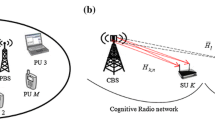Abstract
Based on the analysis of the feature of cognitive radio networks, a relevant interference model was built. Cognitive users should consider especially the problem of interference with licensed users and satisfy the signal-to-interference noise ratio (SINR) requirement at the same time. According to different power thresholds, an approach was given to solve the problem of coexistence between licensed user and cognitive user in cognitive system. Then, an uplink distributed power control algorithm based on traditional iterative model was proposed. Convergence analysis of the algorithm in case of feasible systems was provided. Simulations show that this method can provide substantial power savings as compared with the power balancing algorithm while reducing the achieved SINR only slightly, since 6% SINR loss can bring 23% power gain. Through further simulations, it can be concluded that the proposed solution has better effect as the noise power or system load increases.
Similar content being viewed by others
References
IEEE 802.22 Working Group. IEEE P802.22/D1.0 draft standard for wireless regional area networks part 22: cognitive wireless RAN medium access control (MAC) and physical layer (PHY) specifications: policies and procedures for operation in the TV bands [R]. 2008.
GUAN Q S, YU F R, JIANG S M, WEI G. Prediction-based topology control and routing in cognitive radio mobile ad hoc networks [J]. IEEE Transactions on Vehicular Technology, 2010, 59(9): 4443–4452.
HAYKIN S. Cognitive radio: Brain-empowered wireless communications [J]. IEEE Journal of Select Areas Communications, 2005, 23(2): 201–220.
AEIN J M. Power balancing in systems employing frequency reuse [J]. COMSAT Tech Rev, 1973, 3(2): 277–299.
MEYERHOFF H J. Method for computing the optimum power balance in multibeam satellites [J]. COMSAT Tech Rev, 1974, 4(1): 139–146.
NETTLETON R W, ALAVI H. Power control for a spread spectrum cellular mobile radio system [C]// Proc IEEE Veh Technol Conf. Toronto: IEEE Press, 1983: 242–246.
ZANDER J. Performance of optimum transmitter power control in cellular radio systems [J]. IEEE Transactions on Vehicular Technology, 1992, 41(1): 57–62.
GRANDHI S A, ZANDER J. Constrained power control in cellular radio systems [C]// Proc IEEE 44th Veh Technol Conf, 1994, 2: 824–828.
YATES R D. A framework for uplink power control in cellular radio systems [J]. IEEE Journal of Select Areas Communications, 1995, 13(7): 1341–1347.
GRANDHI S, ZANDER J, YATES R D. Constrained power control [J]. Journal of Wireless Personal Communications, 1995, 1(4): 257–270.
HUANG M, CAINES P E, CHARALAMBOUS C D, MALHAME R P. Power control in wireless systems: A stochastic control formulation [C]// Proc Amer Control Conf. Portland: IEEE Press, 2005, 2: 750–755.
HUANG M, CAINES P E, CHARLAMBOUS C D, MALHAME R P. Stochastic power control for wireless systems: Classical and viscosity solutions [C]// Proc 40th IEEE Conf Decision and Control. Orlando: IEEE Press, 2001: 1037–1042.
SU H J, GERANIOTIS E. Adaptive closed-loop power control with quantized feedback and loop filtering [J]. IEEE Transactions on Wireless Communications, 2002, 1(1): 76–86.
WU J, CHEN C Y. An adjustable fuzzy power control architecture for a multirate WCDMA system [C]// Proc of the 27th Chinese Control Conf. Kunming: Chinese Association of Automation, 2008: 633–637.
CHANG P R, WANG B C. Adaptive fuzzy power control for CDMA mobile radio systems [J]. IEEE Transactions on Vehicular Technology, 1996, 45(2): 225–236.
TSAY M K, LEE Z S, LIAO C H. Fuzzy power control for downlink CDMA-based LMDS network [J]. IEEE Transactions on Vehicular Technology, 2008, 57(6): 3917–3920.
CANALES M, GALLEGO J. Potential game for joint channel and power allocation in cognitive radio networks [J]. IEEE Electronics Lett, 2010, 24: 9–10.
XU B Y, LI S Q. Joint power control in cognitive radio system [J]. Journal of University of Electronic Science and Technology of China, 2008, 37(5): 649–652.
HOANG A T, LIANG Y C. Downlink channel assignment and power control for cognitive radio networks [J]. IEEE Transactions on Wireless Communications, 2008, 7(8): 3106–3117.
SHI Y, THOMAS Y, ZHOU H, MIDKIFF S F. Distributed crosslayer optimization for cognitive radio networks [J]. IEEE Transactions on Vehicular Technology, 2010, 59(8): 4058–4069.
KOSKIE S, GAJIC Z. A nash game algorithm for SIR-based power control in 3G wireless CDMA networks [J]. IEEE Transactions on Networking, 2005, 13(5): 1017–1026.
HUANG C, CHEN K. Dual-observation time-division spectrum sensing for cognitive radios [J]. IEEE Transactions on Vehicular Technology, 2011, 60(8): 3712–3725.
KANG H G, SONG I, YOON S, KIM Y H. A class of spectrum-sensing schemes for cognitive radio under impulsive noise circumstances: Structure and performance in non-fading and fading environments [J]. IEEE Transactions on Vehicular Technology, 2010, 59(9): 4322–4339.
CHEN H, TSE C K, ZHAO F. Optimal quantization bit budget for a spectrum sensing scheme in bandwidth-constrained cognitive sensor networks [J]. IET Wireless Sensor Systems, 2011, 1(3): 144–150.
FCC. Notice of Inquiry and notice of proposed rule making [R]. ET Docket, 2003.
FOSCHINI G J, MILJANIC Z. A simple distributed autonomous power control algorithm and its convergence [J]. IEEE Transactions on Vehicular Technology, 1993, 42(4): 641–646.
SAAD Y. Iterative methods for sparse linear systems [M]. Second Edition. Society for Industrial and Applied Mathematics, 2003: 41–46.
Author information
Authors and Affiliations
Corresponding author
Additional information
Foundation item: Project(61071104) supported by the National Natural Science Foundation of China
Rights and permissions
About this article
Cite this article
Li, F., Tan, Xz. & Wang, L. An uplink power control algorithm using traditional iterative model for cognitive radio networks. J. Cent. South Univ. 19, 2816–2822 (2012). https://doi.org/10.1007/s11771-012-1347-0
Received:
Accepted:
Published:
Issue Date:
DOI: https://doi.org/10.1007/s11771-012-1347-0




